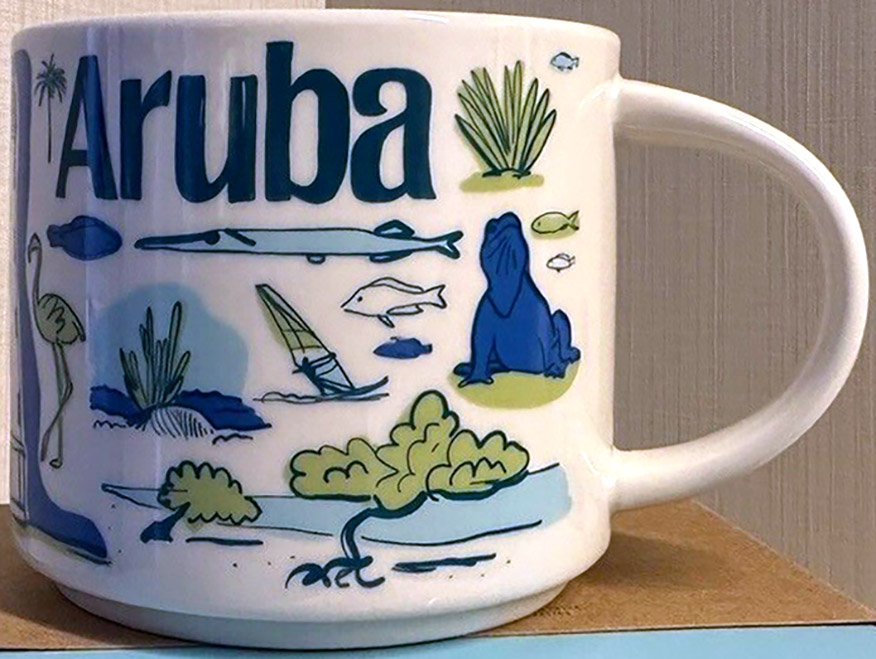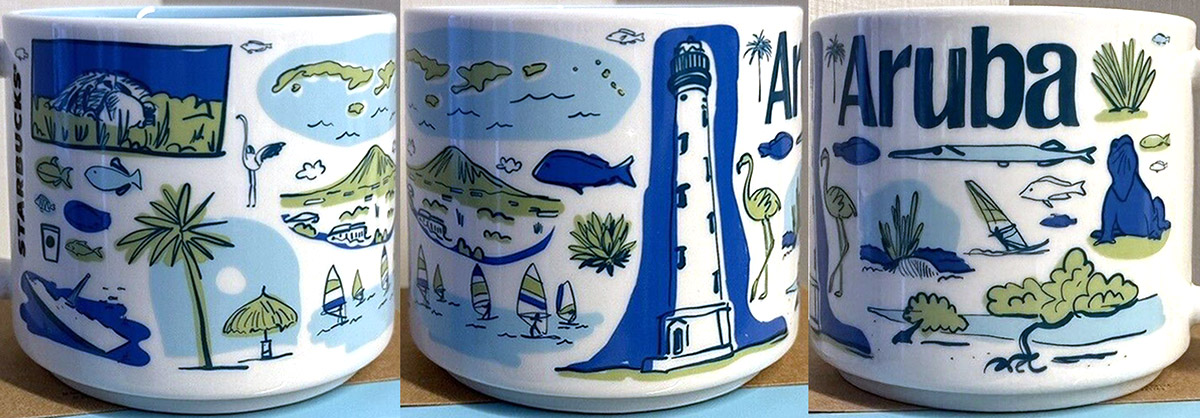
Been There – Aruba
Let’s move to South America for a second and review Starbucks Been There – Aruba mug.
Aruba, a Caribbean gem renowned for its pristine beaches and vibrant culture, boasts a rich history that spans centuries. Believed to have been inhabited as early as 1000 AD by the Caquetio indigenous people, Aruba later became a Spanish colony in the 16th century before falling under Dutch control in 1636. Its name is thought to derive from the Spanish phrase “oro hubo,” meaning “there was gold,” reflecting the island’s once thriving gold mining industry. Despite its small size, Aruba played a significant role in international trade during the colonial era. Today, it stands as an idyllic tourist destination, blending its colonial past with modern luxury and warm hospitality, attracting visitors from around the globe to its sun-kissed shores.
Aruba is a multilingual paradise where Dutch and Papiamento are the official languages, reflecting its colonial heritage and cultural diversity. Papiamento, a Creole language, combines elements of Dutch, Spanish, Portuguese, and indigenous languages, serving as the lingua franca among locals. English and Spanish are also widely spoken, making communication easy for visitors exploring this welcoming island destination.
There is one interesting detail that puzzled me in the design of the mug. Specifically, I can clearly see the map of Greater Antilles which Aruba does not belong to. Instead, Aruba is a part of the Leeward Antilles and the ABC islands in particular: Aruba, Bonaire, and Curaçao. These are linked by a shared political history and under Dutch jurisdiction, they were officially ceded back to the Kingdom of the Netherlands through the Anglo-Dutch Treaty of 1814, subsequently recognized as Curaçao and Dependencies from 1815.
Here are some places to visit when in Aruba:
– Oranjestad, the vibrant capital of Aruba, entices visitors with its charming Dutch colonial architecture and bustling waterfront promenade. This lively city serves as the cultural and commercial heart of the island, offering a delightful fusion of history, shopping, dining, and entertainment.
– Perched majestically on Aruba’s northwestern tip, the California Lighthouse stands as a beacon of history and panoramic beauty. Named after the steamship California, which met its fate on the island’s treacherous shores in the late 19th century, this iconic landmark offers visitors breathtaking views of the surrounding coastline. Originally built in 1910 to guide ships navigating the island’s waters, the lighthouse now serves as a popular tourist attraction, inviting travelers to ascend its spiral staircase and soak in vistas of azure seas and golden sands.
– Arikok National Park, a rugged expanse covering nearly 20% of Aruba’s landmass, beckons adventurers with its striking blend of desert landscapes, towering cliffs, and hidden natural wonders. Home to unique flora and fauna, including cacti, divi-divi trees, and indigenous species like the Aruban burrowing owl, the park offers a captivating journey through the island’s ecological diversity. Visitors can explore ancient cave paintings, hike winding trails to breathtaking viewpoints, or cool off in secluded natural pools nestled among volcanic rock formations.
– There are several shipwrecks near Aruba’s coastline, making it a popular destination for divers and snorkelers interested in underwater exploration. One notable site is the Antilla Shipwreck, which lies just off the northwest coast of Aruba. The Antilla was a German cargo ship scuttled by its crew during World War II to prevent it from falling into Allied hands. Today, it rests on the seabed and has become an artificial reef teeming with marine life, making it a favorite spot for diving excursions.






















































































